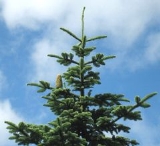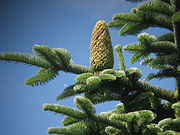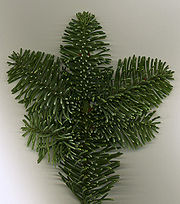
Noble Fir
Encyclopedia
Abies procera, the Noble Fir, is a western North America
n fir
, native to the Cascade Range
and Coast Range
mountain
s of extreme northwest California
and western Oregon
and Washington in the United States
. It is a high altitude tree, typically occurring at 300–1500 m (984.3–4,921.3 ft) altitude, only rarely reaching tree line.

tree
typically up to 40–70 m (130–230 ft.) tall and 2 m (6.5 ft.) trunk diameter, rarely to 90 m (295 ft.) tall and 2.7 m (8.9 ft.) diameter, with a narrow conic crown. The bark
on young trees is smooth, grey, and with resin
blisters, becoming red-brown, rough and fissured on old trees. The leaves
are needle-like, 1-3.5 cm long, glaucous blue-green above and below with strong stomatal bands, and a blunt to notched tip. They are arranged spirally on the shoot, but twisted slightly s-shaped to be upcurved above the shoot. The cones
are erect, 11 – long, with the purple scales almost completely hidden by the long exserted yellow-green bract scales; ripening brown and disintegrating to release the winged seed
s in fall.
 Abies procera is very closely related to Red Fir
Abies procera is very closely related to Red Fir
(Abies magnifica), which replaces it farther southeast in southernmost Oregon and California, being best distinguished by the leaves having a groove along the midrib on the upper side; Red Fir does not show this. Red Fir also tends to have the leaves less closely packed, with the shoot bark visible between the leaves, whereas the shoot is largely hidden in Noble Fir. Red Fir cones also mostly have shorter bracts, except in Abies magnifica var. shastensis; this variety
is considered by some botanists to be a hybrid between Noble Fir and Red Fir.
. The wood
is used for general structural purposes and paper
manufacture.
North America
North America is a continent wholly within the Northern Hemisphere and almost wholly within the Western Hemisphere. It is also considered a northern subcontinent of the Americas...
n fir
Fir
Firs are a genus of 48–55 species of evergreen conifers in the family Pinaceae. They are found through much of North and Central America, Europe, Asia, and North Africa, occurring in mountains over most of the range...
, native to the Cascade Range
Cascade Range
The Cascade Range is a major mountain range of western North America, extending from southern British Columbia through Washington and Oregon to Northern California. It includes both non-volcanic mountains, such as the North Cascades, and the notable volcanoes known as the High Cascades...
and Coast Range
Pacific Coast Ranges
The Pacific Coast Ranges and the Pacific Mountain System are the series of mountain ranges that stretch along the West Coast of North America from Alaska south to Northern and Central Mexico...
mountain
Mountain
Image:Himalaya_annotated.jpg|thumb|right|The Himalayan mountain range with Mount Everestrect 58 14 160 49 Chomo Lonzorect 200 28 335 52 Makalurect 378 24 566 45 Mount Everestrect 188 581 920 656 Tibetan Plateaurect 250 406 340 427 Rong River...
s of extreme northwest California
California
California is a state located on the West Coast of the United States. It is by far the most populous U.S. state, and the third-largest by land area...
and western Oregon
Oregon
Oregon is a state in the Pacific Northwest region of the United States. It is located on the Pacific coast, with Washington to the north, California to the south, Nevada on the southeast and Idaho to the east. The Columbia and Snake rivers delineate much of Oregon's northern and eastern...
and Washington in the United States
United States
The United States of America is a federal constitutional republic comprising fifty states and a federal district...
. It is a high altitude tree, typically occurring at 300–1500 m (984.3–4,921.3 ft) altitude, only rarely reaching tree line.

Description
Abies procera is a large evergreenEvergreen
In botany, an evergreen plant is a plant that has leaves in all seasons. This contrasts with deciduous plants, which completely lose their foliage during the winter or dry season.There are many different kinds of evergreen plants, both trees and shrubs...
tree
Tree
A tree is a perennial woody plant. It is most often defined as a woody plant that has many secondary branches supported clear of the ground on a single main stem or trunk with clear apical dominance. A minimum height specification at maturity is cited by some authors, varying from 3 m to...
typically up to 40–70 m (130–230 ft.) tall and 2 m (6.5 ft.) trunk diameter, rarely to 90 m (295 ft.) tall and 2.7 m (8.9 ft.) diameter, with a narrow conic crown. The bark
Bark
Bark is the outermost layers of stems and roots of woody plants. Plants with bark include trees, woody vines and shrubs. Bark refers to all the tissues outside of the vascular cambium and is a nontechnical term. It overlays the wood and consists of the inner bark and the outer bark. The inner...
on young trees is smooth, grey, and with resin
Resin
Resin in the most specific use of the term is a hydrocarbon secretion of many plants, particularly coniferous trees. Resins are valued for their chemical properties and associated uses, such as the production of varnishes, adhesives, and food glazing agents; as an important source of raw materials...
blisters, becoming red-brown, rough and fissured on old trees. The leaves
Leaf
A leaf is an organ of a vascular plant, as defined in botanical terms, and in particular in plant morphology. Foliage is a mass noun that refers to leaves as a feature of plants....
are needle-like, 1-3.5 cm long, glaucous blue-green above and below with strong stomatal bands, and a blunt to notched tip. They are arranged spirally on the shoot, but twisted slightly s-shaped to be upcurved above the shoot. The cones
Conifer cone
A cone is an organ on plants in the division Pinophyta that contains the reproductive structures. The familiar woody cone is the female cone, which produces seeds. The male cones, which produce pollen, are usually herbaceous and much less conspicuous even at full maturity...
are erect, 11 – long, with the purple scales almost completely hidden by the long exserted yellow-green bract scales; ripening brown and disintegrating to release the winged seed
Seed
A seed is a small embryonic plant enclosed in a covering called the seed coat, usually with some stored food. It is the product of the ripened ovule of gymnosperm and angiosperm plants which occurs after fertilization and some growth within the mother plant...
s in fall.

Red Fir
Abies magnifica, the Red Fir or Silvertip fir, is a western North American fir, native to the mountains of southwest Oregon and California in the United States. It is a high altitude tree, typically occurring at altitude, though only rarely reaching tree line...
(Abies magnifica), which replaces it farther southeast in southernmost Oregon and California, being best distinguished by the leaves having a groove along the midrib on the upper side; Red Fir does not show this. Red Fir also tends to have the leaves less closely packed, with the shoot bark visible between the leaves, whereas the shoot is largely hidden in Noble Fir. Red Fir cones also mostly have shorter bracts, except in Abies magnifica var. shastensis; this variety
Variety (biology)
In botanical nomenclature, variety is a taxonomic rank below that of species: as such, it gets a three-part infraspecific name....
is considered by some botanists to be a hybrid between Noble Fir and Red Fir.
Uses
Noble Fir is a popular Christmas treeChristmas tree
The Christmas tree is a decorated evergreen coniferous tree, real or artificial, and a tradition associated with the celebration of Christmas. The tradition of decorating an evergreen tree at Christmas started in Livonia and Germany in the 16th century...
. The wood
Wood
Wood is a hard, fibrous tissue found in many trees. It has been used for hundreds of thousands of years for both fuel and as a construction material. It is an organic material, a natural composite of cellulose fibers embedded in a matrix of lignin which resists compression...
is used for general structural purposes and paper
Paper
Paper is a thin material mainly used for writing upon, printing upon, drawing or for packaging. It is produced by pressing together moist fibers, typically cellulose pulp derived from wood, rags or grasses, and drying them into flexible sheets....
manufacture.

